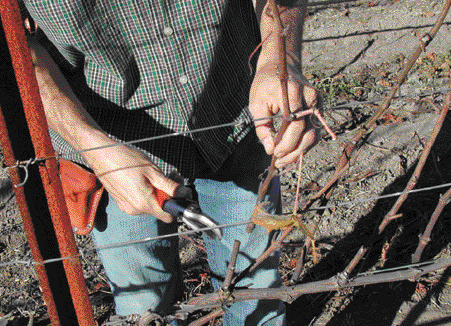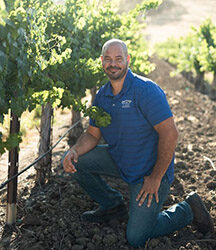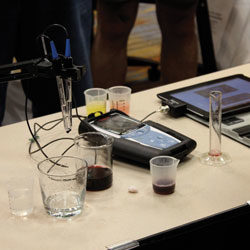This column has become an annual tradition of mine since each year I get quite a few great questions from hobby winemakers regarding their backyard vineyards. So without further ado, let’s jump into some of the best ones from this past year.
Lee in Maryland asks:
This regards pruning before the winter. Just for fun, I planted about 25 vines in my garden in Maryland just to see if they would grow. They went ballistic. Am I correct in assuming that after the vines fully freeze, I should cut back everything that’s green?
Wes Responds:
Timing your pruning is very important for the health and fruitfulness of your vines. You want to wait for two important moments in the vine’s yearly cycle: All leaves should have dropped and when you make test cuts on last year’s cane growth, they will remain dry for five minutes with no liquid “weeping.” Pruning vines that are not fully dormant robs the vine of nutrients it will use to wake up the following spring.
Timing your pruning is very important for the health and fruitfulness of your vines.
It sounds like your vines have no lack of nutrients or vigor, so pruning early would likely have less impact on your vines than on vines that struggle to produce growth and a healthy crop. Your issue will be controlling that vigor to keep the vineyard from growing rank and producing shaded, veggie-tasting fruit. A few good snap freezes should be enough to put your vines fully into dormancy, though I would make a few test cuts just to make sure and to stay in good habits of viticulture.
Fred in Santa Maria, California asks:
For yet another drought harvest on the Central Coast of California, we had an amazing quality harvest — a little lower yields, but quality and flavor seem to me the best I’ve tasted in 25 years of home winegrowing and winemaking here in Santa Barbara County. My question today is about the drought. How can I tighten my water management in the vineyard and how will varying levels of deficit irrigation (giving the vine less water than it wants/needs) impact growth, canopy, and fruit quality? How do I know if I can get away with dry farming, or zero added irrigation?
Wes Responds:
Fred, nice to hear from another Santa Maria grape fanatic. Hope all is well and you enjoyed that amazing 2021 vintage here — perfect weather for a legendary year. Water management in the vineyard is a complicated subject with reams of literature, but I will summarize from my experience what could help growers in drought situations.
First and foremost, my 24 years of vineyard management experience taught me a valuable lesson — that most European grapevines (the ones we generally use in California to grow wine), and often hybrids and native U.S. vines, are very judicious in their use of water. They have evolved to deal with times of wet and dry soil, and even make it through droughts. Even an abandoned 19th century Mission Grape vineyard was discovered near Lompoc, California and nursed back to health in the 1990s after decades of neglect and severe drought. So the first point is good news — it’s difficult to kill a vine, and the vine is dynamic in its ability to find resources or handle some drought and heat.
Vineyard water status can be measured by an in-ground tensionmeter (such as an Irrometer), by using a pressure bomb on the fresh, green leaves, or by using a very easy and reliable method: The angle of the petiole (leaf stem) to the leaf blade. You want to see the stem of the leaf at a 90-degree angle to the leaf for optimal vine water status. If the angle droops (acutely), the vine is in some water stress, the more the droop, the worse. If the angle is obtuse or more than 90 degrees, the vines likely have excess water, which can lead to dilute fruit and rampant vegetative growth.
Now that you know what to look for, we start with winter/spring rains. If the vineyard soil was saturated with at least 15–20 in. (38–51 cm) of seasonal dormant season rains, the soil profile should be fully charged with water and you can likely wait until May to water in warmer climates, maybe as late as June in cooler climates like Santa Maria. Of course, monitor the vines’ health and apply water if they seem to be stressed from dry soil. Remember clay holds more water while sand holds close to none.
So practically, if we receive very limited rain again this dormancy (only 3 in./8 cm last year), I would repeat your successful irrigation program from 2021, but cut your irrigation sets by 20% and see what happens. If normally healthy vines lose their balance and vigor, all other cultural practices being the same, move back up to 100% normal. If 20% deficit works for you, try 30% the year after, then 40%, etc. You want to watch for optimal balance: 12–15 leaves per cluster, canes around 3–4 ft. (0.9–1.2 m), and vines that stay healthy and viable through harvest. Knowing Santa Maria as I do, without serious changes in historical rainfall patterns, dry farming is not recommended. I usually green-light dry farming a vineyard in areas with at least 25 in. (64 cm) of average annual rainfall.
As far as canopy, if the bottom leaves (the oldest) begin to yellow or dry out months before harvest, that is a good sign you need to increase water to the vines earlier in the season. Yellowing/desiccation of leaves late in the season, or at harvest, is normal, although I like to see green leaves in the vineyard during ripening and up to harvest (a few red/yellow leaves are normal in fall).
Lastly, on wine quality, allow the vines to dry out right after fruit set as the vine determines berry size. Deficit irrigation after berry set will increase skin-to-juice ratio and will generally improve flavor and concentration in all wines. Hope that helps!
Dave near Jefferson City, Missouri writes:
Wes, I have a few questions for you. The first two regard pruning style — what is the quality difference, if any, between spur pruning and cane pruning? Also, what is the labor difference in time per vine? Lastly, I’ve heard vines can die in very cold temperatures. Is this true, and at what point does a vineyard have to be pruned and buried under soil for survival? Thanks in advance.
Wes Responds:
Dave, say hi to Jefferson City for me, I have great memories of that town (and the BBQ all over that state). Pruning questions are very popular right now, as most of us are getting into the vineyard to get that vineyard ready for spring! Pruning style is a good subject for debate. Here is a problem that is ubiquitous in viticulture and winemaking: That of tradition vs. anecdote. Libraries are filled with unread books on this subject and winegrowers and makers seem to prefer to use the traditions that they grew up with or were taught by their mentors. That being said, there is a belief in traditional grape growing circles that spur/cordon pruning systems are easier to teach and faster to complete while cane-pruned systems require more expertise, time, choices, and produces superior fruit — especially in Pinot Noir and Chardonnay.

I will agree that spur pruning is faster and easier, but I have no way of determining if fruit grown on fresh canes each year are better for the wine, but I doubt that is the case from my own experience. The first commercial vineyard I managed started with cane pruning for 10 years and then the last 12 years I was there we used spur/cordon. I saw better balance and fruit distribution in the canopy using spur and it would be difficult to suggest cane pruning as a consultant. Canes tend to produce a lot of fruit at either end, and tend to have blind positions in the middle that lack crop. All in all, and especially for hobbyists, my suggestion is to go with spur/cordon. One problem with spur training, though, is that improper pruning can lead to very high spur positions, which can mess up the functionality of the trellising system. Keep your spurs as low as you can; always retain the lowest option for your retained spurs or they will creep higher and higher.
Labor time between cane and spur pruning varies by expertise, and I would say an untrained worker should not be allowed to cane prune even if they are careful. Choosing the right “sun canes” and ones of the right size and location can be challenging, and it’s easy to break the canes and lose half of a vine’s fruit in a second or less. Spur pruning is like giving a careful haircut, and as long as you keep those spur positions managed and low on the cordon, you should be good. Depending on the age and size of the vine, a good pruner should be able to spur prune a vine in 1–2 minutes, cane pruning could extend to 2–3 minutes.
As far as “winter kill” of grapevines is concerned, most viticulturists would worry about their vineyards’ survival when temperatures fall below or significantly below 0 °F (-18 °C). Sudden temperature drops can cause even more danger to the vines. Vitis vinifera, the European winegrape that makes the world’s greatest wines, evolved originally between the Black and Caspian seas, and those bodies of water kept the area from getting too cold, even in the last ice age. So vines do have protection against cold, but only to about that temperature. French-American hybrids normally have better cold resistance, and different varietals are impacted differently. For example, Merlot can die at 0 °F (-18 °C), Pinot Noir at -5 °F (-21 °C), but Concord can generally handle down to -25 °F (-32 °C)! Burying a pruned vine in winter is done commonly in the Northern Tier of the U.S. and other frigid winter climates, and is accomplished by digging a trench on either side of the low-trellised trunk and burying the retained canes, or even hilling over the whole vine. In areas with deep, reliable snow all winter, snow can be used to cover the vine as well. In the Finger Lakes region of New York, it is common to keep two trunks on every vine, so if one has winter kill, the second trunk can be used to keep the vine alive and producing. And before you think it can never happen in Missouri, I see that St. Louis recorded -22 °F (-30 °C) back in 1844! But in normal conditions, your vines should be fine, especially if they are Norton. Stay warm out there, just writing this made me cold.
Bill near Houston, Texas asks:
If you had to summarize three ideas in the vineyard that have the greatest impact on improving resulting wine quality, what would they be?
Wes ponders and replies:
- Leaf-to-cluster ratio counting and fine-tuning. Dr. Richard Smart, in his groundbreaking book Sunlight Into Wine (buy it if you haven’t already) gave viticulturists all over the world a number of vital and brilliant tools for managing winegrape vineyards. In a grape world where we generally have to deny “vanilla advice” that applies to everyone, Smart gave us a magic number: All wine vineyards should have 12–15 leaves per cluster at the onset of fruit ripening. Does that mean we have to count our grape bunches and leaves on every vine, every year? Well, no not exactly, but if you only have 10 vines, why not? I would generally make my interns (spooky music) count 100 vines in each block of 2–3 acres, and to choose the vines randomly to give us a decent average that can impact canopy management. This ratio also influences how we handle stunted vines or stunted shoots.
I recommend dropping all fruit from any shoot that does not have at least 10 leaves, but allow it to grow. If a shoot has at least 20 leaves by bloom/set, I would leave two clusters on that shoot. If the foliage is weak, with too many clusters, thin the clusters down, shoot per shoot, down to around 12 leaves to a cluster. Tweak the ratio a bit for cluster size . . . I’m used to Pinot Noir and Chardonnay bunches that are tiny, so 10:1 works pretty well. With Grenache or other large-clustered varietals, 15:1 is a better ratio. What if you have 30 leaves per cluster, and the imbalance goes the other way? You can leaf-pluck not only in the fruit zone as normal, but also “scoop” interior leaves that are shaded most of the day, or even hedge the vines’ tops, although that can generate more growth in a week or two. - Sunlight on winegrapes, without burning them, is the single most important element of viticulture. Galileo said “Wine is sunlight, held together by water,” and he was right! Never pull so many leaves as to cook or raisin your fruit but constantly test, adjust, and take notes on how open you can get your fruiting zone to sun and wind without burn. All winegrapes have a compound within the berries called ‘pyrazine’ (or methoxypyrazine to be precise) that tastes like green bell peppers. Flecking or direct sun exposure causes chemical bond changes in the pyrazines and almost miraculously shifts them to the ‘terpene’ family, which increases high-toned berry character in red wine and floral/honey aroma in white. What a great deal! There is an abundant, free resource that can make your wines better. Now to just figure out how many leaves to pull around the fruit to balance sound, unburned fruit and allowing the sunshine to make better and better wine.
- Many hands make light work, and bigger is usually better. I’m obviously cheating here to get an extra suggestion in. Working in the vineyard is much more efficient, fun, and social with lots of help. “Normies” (people without vineyards) even think working in the vines is romantic . . . at least for 15 minutes! Start a “wines and vines club” and have weekend workdays to do hoeing, canopy management, leaf pulling, pruning, and harvest. Also consider harvesting at night with headlamps. It’s quite comfortable and even magical. The bonus suggestion is to go big with your equipment. If you can afford an ATV with a PTO spray rig, go for it! Machinery, and especially a spray rig for fungicide application, can really make your vineyard work easier and less backbreaking.
That’s our Q&A for another year in the vineyard. Please stay in touch and send any questions you have my way: [email protected]. Cheers!






